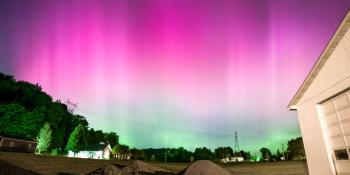Viendo archivo del viernes, 3 diciembre 2004
Informe actividad solar
Any mentioned solar flare in this report has a scaling factor applied by the Space Weather Prediction Center (SWPC). Because of the SWPC scaling factor, solar flares are reported as 42% smaller than for the science quality data. The scaling factor has been removed from our archived solar flare data to reflect the true physical units.
Informe de actividad Solar-Geofísica 2004 Dec 03 2200 UTCPreparado por NOAA © SWPC y procesado por SpaceWeatherLive.com
Informe conjunto USAF/NOAA de actividad Solar y Geofísica
SDF Número 338 Publicado el 2200Z a las 03 Dec 2004IA. Análisis de regiones solares activas y de actividad desde 02-2100Z hasta 03-2100Z Solar activity was moderate. Region 708 (N08W12)
produced an M1/2f flare at 03/0006UTC. This flare was associated
with a full-halo CME and significant radio emission that included a
520 sfu burst at 2695 MHz and type II/IV sweeps. The sunspot
configuration has remained relatively unchanged following the flare.
Region 707 (S14W49) was stable. New Region 709 (N06E61) was
numbered.
IB. Pronóstico de la actividad solar
Solar activity is expected to be low.
Occasional C-class flares are possible in Regions 707 and 708.
Another M-class flare may occur in 708.
IIA. Resumen de la actividad geofísica 02-2100Z a 03-2100Z
The geomagnetic field was quiet. The proton flux at greater than 10
MeV is enhanced as a result of the M1 flare discussed in Part IA but
has not yet crossed the 10 pfu event threshold. The greater than 2
MeV electron flux at geosynchronous orbit was high. The
Fredericksburg A index reported in Part V is estimated from Boulder
observations.
IIB. Pronóstico de la actividad geofísica
The geomagnetic field is
expected to be quiet until the arrival of the CME associated with
the M1 flare discussed in Part IA. The arrival of the CME is
anticipated late on 04 Dec after which geomagnetic conditions are
expected to be at storm levels. A coronal hole high-speed stream is
also expected to begin to affect geomagnetic activity within the
same time period. The greater than 10 MeV proton flux may increase
with the arrival of the CME but is currently not expected to exceed
the event threshold.
III. Probabilidades del evento 04 Dec a 06 Dec
| Clase M | 20% | 20% | 20% |
| Clase X | 01% | 01% | 01% |
| Protón | 05% | 01% | 01% |
| PCAF | green | ||
IV. Penticton 10.7cm flujo
Observado 03 Dec 101 Previsto 04 Dec-06 Dec 095/095/090 Media de 90 Días 03 Dec 108
V. Índices Geomagnéticos A
Observado Afr/Ap 02 Dec 004/004 Estimado Afr/Ap 03 Dec 004/004 Previsto Afr/Ap 04 Dec-06 Dec 010/015-035/040-015/020
VI. Probabilidades de Actividad Geomagnética 04 Dec a 06 Dec
| A. Latitudes Medias | |||
|---|---|---|---|
| Activo | 30% | 60% | 30% |
| Tormenta Menor | 10% | 20% | 10% |
| Tormenta Mayor-Severa | 05% | 10% | 05% |
| B. Latitudes Altas | |||
|---|---|---|---|
| Activo | 50% | 25% | 40% |
| Tormenta Menor | 30% | 50% | 20% |
| Tormenta Mayor-Severa | 15% | 25% | 10% |
All times in UTC
< < Ir a la visión general diaria
Últimas noticias
Últimos mensajes del foro
Filaments and prominences 130AR3685 64Latest SC25 Predictions 127What makes AR3684 magnetically distinct from AR3685? 6Unproven theories 481
Más temasApoye a SpaceWeatherLive.com!
Mucha gente viene a SpaceWeatherLive para seguir la actividad del Sol o previsión de aurora, pero con esta cantidad de tráfico se incrementan los costos del servidor. ¡Considere hacer una donación si disfruta de SpaceWeatherLive para que podamos mantener el sitio web en línea!

Hechos clima espacial
| Último evento clase X | 2024/05/15 | X2.9 |
| Último evento clase M | 2024/05/19 | M1.8 |
| Últimas tormentas geomagnéticas | 2024/05/17 | Kp6 (G2) |
| Días sin manchas | |
|---|---|
| Último día sin manchas | 2022/06/08 |
| Promedio de manchas solares mensuales | |
|---|---|
| abril 2024 | 136.5 +31.6 |
| mayo 2024 | 157.7 +21.2 |
| Last 30 days | 171.7 +57.7 |


